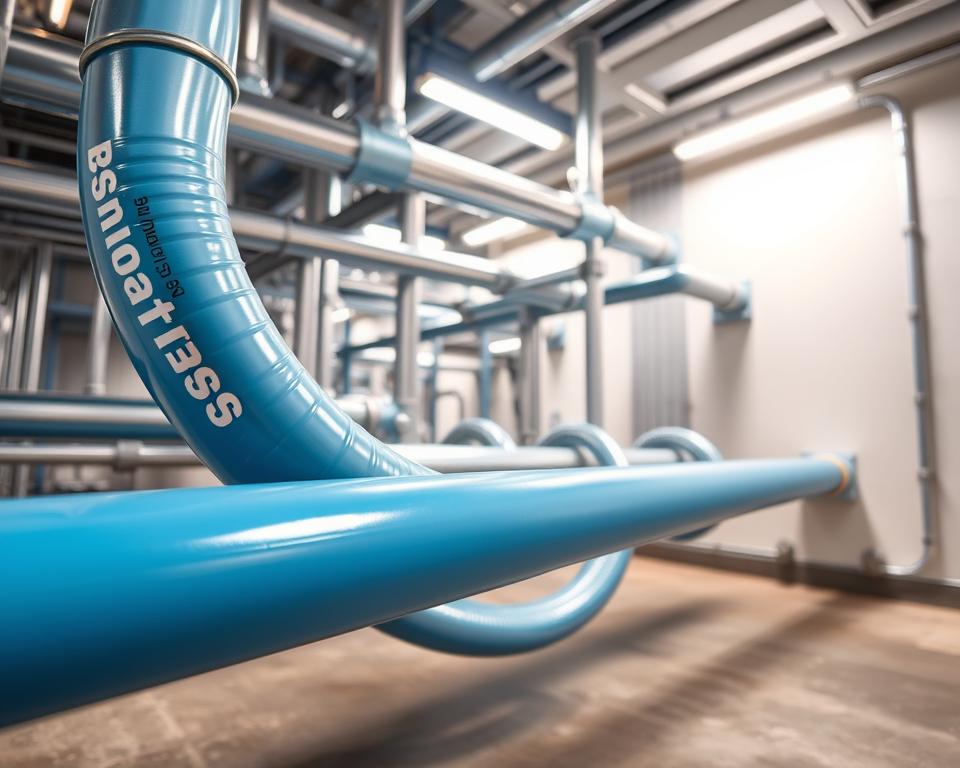Everything You Need to Know About PVC Air Compressor Piping
Did you know that a ruptured compressed air system can release energy equivalent to a stick of dynamite? Despite the hazards, numerous workshops continue installing piping systems from unsafe materials. This guide explains why safety should come first when using PVC air lines.
Even as interest rises, OSHA bans these materials for above-ground compressed air. Oil contact and repeated temperature swings degrade these pipes, risking sudden ruptures. Safe-rated pressures can still result in deadly bursts.
For reliable alternatives, Installation Parts Supply offers durable solutions like aluminum. Investing in proper materials avoids costly fines and keeps workplaces secure. Let’s explore how to build a safer system.

Critical Points
- OSHA bans certain materials due to explosion risks.
- Heat and cold swings slashes claimed pressure capacity.
- Long-term exposure makes pipes prone to brittle breaks.
- Aluminum piping offers a safer alternative.
- Proper investment prevents costly fines and accidents.
The Risks of PVC in Air Compressor Lines
Manufacturers explicitly warn against using some plastics for high-energy applications. Compressed air carries destructive energy; a burst is like a dynamite blast. This makes material choice critical for safety.
- Brittleness: Sub-freezing temperatures turn materials brittle, increasing fracture risks.
- Adhesive failures: Temperature changes and oils cause adhesive joints to fail.
- Misleading ratings: Most shops run above 110°F, slashing rated pressure in two.
After a PVC burst hurt staff, OSHA levied a $110,000 fine. The “heat of compression” further reduces safe operating limits, a factor often overlooked in ratings.
“Above-ground use of certain plastics for compressed air violates OSHA standards due to explosion risks.”
Steel and aluminum curve under stress instead of shattering. Fragments from PVC blasts can hurl past 50 feet, embedding dangerously.
Daily heat and cold cycles in a workshop degrade plastics rapidly. Over 10 years, UV exposure and chemical interactions further compromise integrity, turning minor leaks into major hazards.
Safe Alternatives to PVC Pipe for Air Compressor Lines
Aluminum air lines deliver superior safety and leak reduction. They leak 90% less than black iron, making them ideal for today’s shops. Lightweight, rust-proof aluminum stands up to years of service.
Modular aluminum setups save time—no threading required. Prebuilt snap-together aluminum runs come from Installation Parts Supply. A car plant saw a 40% drop in labor expenses after aluminum installation.
- Copper: Ideal in sterile environments for its germ-killing copper surface. Requires soldering expertise.
- Stainless Steel: Resists rust in humid areas like coastal workshops.
- ABS/HDPE: For solvent-rich environments, ABS/HDPE stays intact.
“Our aluminum retrofit reduced energy waste by 15%—paying for itself in 18 months.”
Proper torque is critical. Over-tightened fittings crack, while loose ones leak. Follow manufacturer specs—typically 25–30 ft-lbs for aluminum joints.
For food-grade applications, NSF-certified options ensure air purity. Pick piping suited to your facility’s conditions.
Material Selection Guide for Compressed Air
Selecting the best material for your setup requires balancing cost, safety, and efficiency. A Midwest factory saved $12,000 annually by switching to leak-resistant aluminum. Follow these tips to pick wisely.
| Material | Cost (per ft) | Maintenance | ROI Time |
|---|---|---|---|
| Aluminum | $8.50 | Low | 18 months |
| Black Pipe | $5.00 | High | N/A |
| Copper | $10.20 | Medium | 24 months |
Don’t ignore thermal limits. Aluminum handles -40°F to 200°F, while plastics crack below freezing. Use stainless steel where solvents are present.
Pro Tip: Use leak-loss math to estimate ROI. Don’t let 10% leakage cost you $3,500 a year.
- Ensure your pipe PSI rating exceeds system pressure.
- Keep records of inspections and tests to satisfy OSHA.
- Request a free system audit from Installation Parts Supply.
“Our aluminum retrofit cut energy waste by 15%—paying for itself in 18 months.”
Hire pros for big installs to guarantee airtight connections. Don’t forget to read the fine print on warranty lengths.
In Summary
Safety outweighs sticker price in compressed-air piping. Ninety-two percent of pipe failures occur in aging lines, frequently causing injuries. Aluminum offers 99.8% reliability, making it a smart long-term choice.
Key takeaways:
- Avoid brittle materials that shatter under pressure.
- Opt for corrosion-resistant metals like aluminum or stainless steel.
- Non-compliant systems risk OSHA fines and insurance issues.
Ready to upgrade? Grab same-day pricing and deals on kits from Installation Parts Supply. Download our free maintenance template or call for emergency replacements.
Invest in secure lines now to protect your crew.
